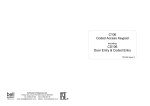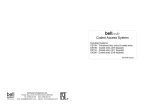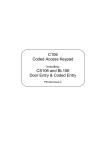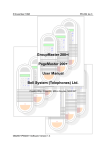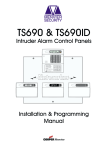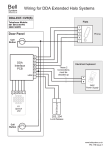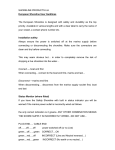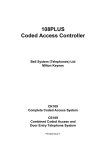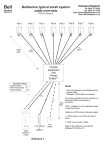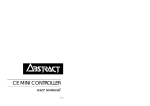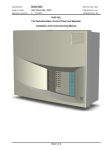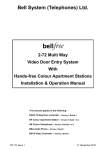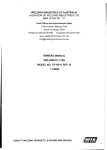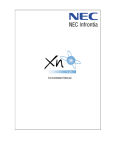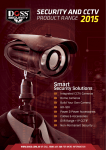Download S105 User Manual (PD-016 Iss 2) - Intercom Repairs London, All
Transcript
S105 Coded Access Controller Including Systems; CS109 - Combined door entry & coded entry CK111 - Coded entry (216 keypad) CK112 - Coded entry (217 Keypad) PD-016 Issue 2 Bell System (Telephones) Ltd. Presley Way, Crown Hill, Milton Keynes MK8 0ET. Tel: 01908 261106 FAX: 01908 261116 email: [email protected] website: www.bellsystem.co.uk S105 Coded Access Controller Summary of Features S105 Coded Access Controller Contents ! Up to 10 codes each of 1 - 8 Digits. ! Time restricted access. ! Duress Operation. ! Exit Facility. ! Lock Timer. ! Secure Programming via Keypad. ! Integrated PSU and Controller. ! Battery Backup Capability. ! Non-volatile Memory. General Description . . . . . . . . . . . . . . . . . . . . . . . . . . . . . . . . . . . . . . . . . . . . . 5 Basic Operation . . . . . . . . . . . . . . . . . . . . . . . . . . . . . . . . . . . . . . . . . 5 Main Features: . . . . . . . . . . . . . . . . . . . . . . . . . . . . . . . . . . . . . . . . . . 6 System Components . . . . . . . . . . . . . . . . . . . . . . . . . . . . . . . . . . . . . . . . . . . 10 Model S105 Control Unit . . . . . . . . . . . . . . . . . . . . . . . . . . . . . . . . . Power Supply . . . . . . . . . . . . . . . . . . . . . . . . . . . . . . . . . . . . . . . . . . Electric Lock releases . . . . . . . . . . . . . . . . . . . . . . . . . . . . . . . . . . . Model 216 & 217 Keypad . . . . . . . . . . . . . . . . . . . . . . . . . . . . . . . . . 10 11 11 12 Wiring for the S105 Controller . . . . . . . . . . . . . . . . . . . . . . . . . . . . . . . . . . . . 13 Products S105 Installation Instructions . . . . . . . . . . . . . . . . . . . . . . . . . . . . . . . . . . . . . . . . . 14 Coded access controller CK111 Complete kit incorporating S105 and 216 keypad CK112 Complete kit incorporating S105 and 217 keypad CS109 Combined coded access and door entry system 1 Cable requirements . . . . . . . . . . . . . . . . . . . . . . . . . . . . . . . . . . . . . Fitting the Power Supply/Control Unit . . . . . . . . . . . . . . . . . . . . . . . Important Safety Information . . . . . . . . . . . . . . . . . . . . . . . . . . . . . . Cables . . . . . . . . . . . . . . . . . . . . . . . . . . . . . . . . . . . . . . . . . . . . . . . . Battery . . . . . . . . . . . . . . . . . . . . . . . . . . . . . . . . . . . . . . . . . . . . . . . Installing the keypads . . . . . . . . . . . . . . . . . . . . . . . . . . . . . . . . . . . . Electric Lock Release . . . . . . . . . . . . . . . . . . . . . . . . . . . . . . . . . . . . High current lock releases . . . . . . . . . . . . . . . . . . . . . . . . . . . . . . . . High Current Lock Release . . . . . . . . . . . . . . . . . . . . . . . . . . . . . . . Alarm Output . . . . . . . . . . . . . . . . . . . . . . . . . . . . . . . . . . . . . . . . . . Time-clock . . . . . . . . . . . . . . . . . . . . . . . . . . . . . . . . . . . . . . . . . . . . Exit Button . . . . . . . . . . . . . . . . . . . . . . . . . . . . . . . . . . . . . . . . . . . . 2 14 15 15 16 16 17 18 19 19 20 20 21 S105 Coded Access Controller S105 Coded Access Controller Programming the S105 . . . . . . . . . . . . . . . . . . . . . . . . . . . . . . . . . . . . . . . . . 22 Specification for the S105 Controller . . . . . . . . . . . . . . . . . . . . . . . . . . . . . . 49 General . . . . . . . . . . . . . . . . . . . . . . . . . . . . . . . . . . . . . . . . . . . . . . . Programming a New Access Codes (Functions 1 to 10) . . . . . . . . . Choosing an access code . . . . . . . . . . . . . . . . . . . . . . . . . . . . . . . . . Programming the Action Codes (Functions 51 to 60) . . . . . . . . . . . Changing the Security key (Function 91) . . . . . . . . . . . . . . . . . . . . . Programming a Code Entry Time Limit (Function 94) . . . . . . . . . . . Programming The Lock Duration (Function 95) . . . . . . . . . . . . . . . . Programming a Lock Delay Time (Function 96) . . . . . . . . . . . . . . . Programming The Alarm Duration (Function 97) . . . . . . . . . . . . . . . Programming The Key Limit (Function 98) . . . . . . . . . . . . . . . . . . . Programming the Factory Settings from the Keypad (Function 99) ............................................... 22 23 24 25 27 28 29 30 31 32 33 Summary of Program Functions . . . . . . . . . . . . . . . . . . . . . . . . . . . . . . . . . . 35 Table 1 - Programming Access Codes . . . . . . . . . . . . . . . . . . . . . . . Table 2 - Programming of Other Functions . . . . . . . . . . . . . . . . . . . Table 3 - Programming of Action Codes . . . . . . . . . . . . . . . . . . . . . Table 4 - Summary of Action Numbers . . . . . . . . . . . . . . . . . . . . . . 35 36 37 38 Combined Door Entry and Coded Access Controller . . . . 51 General Description . . . . . . . . . . . . . . . . . . . . . . . . . . . . . . . . . . . . . . . . . . . . 52 CS109 Complete Systems . . . . . . . . . . . . . . . . . . . . . . . . . . . . . . . . 52 Installation of the Door Entryphone System . . . . . . . . . . . . . . . . . . 53 Cable Planning . . . . . . . . . . . . . . . . . . . . . . . . . . . . . . . . . . . . . . . . . . . . . . . 54 Cable requirements . . . . . . . . . . . . . . . . . . . . . . . . . . . . . . . . . . . . . 55 Installation Procedure . . . . . . . . . . . . . . . . . . . . . . . . . . . . . . . . . . . 56 Troubleshooting . . . . . . . . . . . . . . . . . . . . . . . . . . . . . . . . . . . . . . . . . . . . . . . 57 Testing and Troubleshooting . . . . . . . . . . . . . . . . . . . . . . . . . . . . . . . . . . . . . 39 Programming the Factory Settings Using the Test Button . . . . . . . . 41 CS109 - 1 Wiring . . . . . . . . . . . . . . . . . . . . . . . . . . . . . . . . . . . . . . . . . . . . . . 60 Testing The S105 . . . . . . . . . . . . . . . . . . . . . . . . . . . . . . . . . . . . . . . . . . . . . . 43 CS109 - N Wiring . . . . . . . . . . . . . . . . . . . . . . . . . . . . . . . . . . . . . . . . . . . . . 61 Testing The Lock Release Outputs . . . . . . . . . . . . . . . . . . . . . . . . . Testing the Alarm Outputs . . . . . . . . . . . . . . . . . . . . . . . . . . . . . . . . Testing the Keypad . . . . . . . . . . . . . . . . . . . . . . . . . . . . . . . . . . . . . . Keypad Matrix . . . . . . . . . . . . . . . . . . . . . . . . . . . . . . . . . . . . . . . . . . Testing the controller with factory settings . . . . . . . . . . . . . . . . . . . . 3 43 45 46 47 48 4 S105 Coded Access Controller S105 Coded Access Controller General Description Main Features: The S105 Coded Access Controller is a high quality, versatile security product, controlling access to one door by means of a keypad and an electric lock release Multi-coded mechanism. The S105 has ten access codes available each of which can be 1 to 8 digits long. The extra codes are provided for a variety of possible uses:- Basic Operation C Multi-user applications, e.g. for a small office block. If a valid code is entered on the keypad, the lock release will operate for a preset C Time-restricted access (described below). duration. C Duress access (described below). The S105 Controller may be programmed with up to ten unique access codes. The controller may be programmed to operate an audible alarm under various circumstances, for example, if an invalid code has been repeatedly entered; the Time-Restricted Access (Staff/Executive Operation) alarm will operate for a preset period, during which time the lock release cannot Any of the ten access codes may be programmed to operate during a restricted operate. time period, i.e. when an external time-clock switch is either open or closed. The keypad has one green and one red LED to indicate the system status to the user; the green LED indicates that the lock release is operating, whilst the red For example, with factory settings, the operation of code 1 is unrestricted LED indicates an invalid entry or an alarm condition. (Executive Code) whilst code 2 is restricted to when the time-clock input is closed (Staff Code). Two codes could also be programmed to operate during alternate shifts. E.g. code 1 operates when the time-clock input is open and code 2 operates when the time-clock input is closed. Refer to ‘Programming the Action Codes’ page 25 and Table 1 page 37 for further details. 5 6 S105 Coded Access Controller S105 Coded Access Controller Duress Access Non-Volatile Memory Any of the ten access codes may be set to duress mode. When a duress code The access codes and user programs are stored in a protected non-volatile is entered, the lock release will operate normally but immediately afterwards EEPROM memory, which does not rely on batteries. The access codes and activate an alarm. The alarm device should be a discreet sounder or indicator other programmable parameters are retained indefinitely without power. designed to alert security staff. Alternatively, the duress code can be programmed to directly operate the alarm, without releasing the door. Integrated Power Supply With Optional Battery Backup The S105 controller is mounted in a rugged steel enclosure complete with an Refer to ‘Programming the Action Codes’ page 25 and Table 1 page 37 for integral power supply . This cost-effective approach, significantly reduces the further details. number of system components and the amount of cabling. There is provision for an optional battery, which will maintain system operation Exit Facility in the event of a mains failure. The Exit facility allows the lock release to be operated directly from a push-button (for the preset time period). Typically this would be used to allow personnel to freely exit through the controlled door. The facility may also be used for a Fireman’s keyswitch, or to interface with other security products such as a Door Entry Telephone System. Lock Delay If required, the lock release can be programmed to operate after a preset time delay, following entry of the access code. This function is useful if the keypad is located a long way from the entrance. 7 8 S105 Coded Access Controller S105 Coded Access Controller System Components Programmable Options In addition to the ten access codes the user may program the following other functions: Model S105 Control Unit L Lock duration (1-99 seconds) The Controller PCB is housed in a strong steel enclosure. Security can be L Lock delay time (0-99 seconds) further enhanced by placing the controller in a secured area. This arrangement provides a superior level of security when compared to the many combined L Alarm duration (1-99 seconds) keypad/controller units on the market, where access can usually be attained by L Key entry limit (0-99 seconds) vandalism of the keypad; with a correctly installed S105 system this is L Code entry time limit (0-99 seconds) impossible. L Time-restricted access mode L Duress access mode. Note Due to the presence of Mains voltages the lid of the S105 should only be removed by qualified personnel. Access is not required for programming. 9 10 S105 Coded Access Controller S105 Coded Access Controller Model 216 & 217 Keypad Power Supply The Model 216 and 217 are 12-key Stainless-Steel Keypads, offering a high level The S105 controller has its own internal Power Supply, rated at 12VDC and of vandal and water resistance (i.e. suitable for indoor or outdoor use), and 0.8Amp. This power supply is sufficient to operate the Controller, a lock release available with either an attractive alloy-cast surface-mounting enclosure or a (max. 0.5A), a speech unit (see combined systems, page 50) and also to charge flush-fitting (216 only) Zintec back-box. A red and a green LED indicator are the battery; if fitted. provided for status indication; Green indicates door open; Red indicates alarm condition. Electric Lock releases The S105 Controller has outputs for both Fail-secure and Fail-safe Lock Releases. These will drive a wide range of devices including magnetic locks. 11 12 S105 Coded Access Controller S105 Coded Access Controller Wiring for the S105 Controller Installation Instructions Read carefully all of the information presented in this chapter and then install the system in accordance with the wiring diagram on page 13. Cable requirements Unless otherwise specified below, it is recommended that the system be installed with solid-core telephone cable such as BT specification CW1308. Connections No. of Cable length cores Core diameter Keypad 10 100M max. 0.5mm Lock release (up to 500mA) 2 up to 25M 0.5mm up to 100M 1.0mm Alarm output (up to 50mA) 2 up to 100M 0.5mm Time 2 100M max. 0.5mm Exit 2 100M max. 0.5mm In most cases cable length restrictions should not present a problem, however where longer lengths are required please refer to the manufacturer for advice. 13 14 S105 Coded Access Controller S105 Coded Access Controller Fitting the Power Supply/Control Unit Cables The S105 controller is supplied in a steel box which should be installed in a protected indoor environment. The box contains a number of mounting holes Use only mains cable to BS6004, BS6500, or equivalent, within the following and conduit holes, for safety reasons do not alter the box in any way. specified limits: When removing or replacing the lid take care not to damage or trap the earth leads. For safety always ensure the earth leads are correctly connected. Minimum Maximum Conductor Diameter 1.0mm (0.75mm2) 2.25mm (4mm2) Cable Diameter 4.0mm 8.0mm Important Safety Information Battery The S105 Unit and any other mains-powered equipment (e.g. Time-Clock) must be placed in a protected indoor environment, close to a 240V electrical supply, Care must be taken to ensure the battery terminals are not shorted together by e.g. an electrical cupboard. Connections to the 240V AC mains supply must be metal objects as this may constitute a Fire Hazard. carried out by a qualified electrician or similar competent person, and made in accordance with accepted safety practices. Observe the correct polarity when connecting: A good mains safety earth must be connected to the S105. A two-pole switch (as provided by a Consumer Unit or Switch-Fuse) must be Red wire Positive Black wire Negative included to isolate both Live and Neutral during Installation or Maintenance. The ¿ × circuit must be protected by a current limiting fuse or other device with a The Battery is protected by a fuse, always replace this with the correct type and maximum rating of 5A. rating: The transformer is protected by a fuse; always replace this with the correct type F1A 250V and rating: (20mm glass fuse, 1A, Fast Blow, approved to BS EN 60127 or equivalent.) T100mA 250V (20mm glass fuse, 100mA, 250V, Time delay, approved to BS EN 60127 or equivalent.) 15 Battery type: 12V 2AH e.g. YUASA NP1.9-12 16 S105 Coded Access Controller S105 Coded Access Controller Electric Lock Release Installing the keypads The S105 Controller PCB provides two alternative pairs of connections for an The keypad is supplied with an Allen key for removing the security screws in the front panel and gaining access to the terminals. When fixing the keypad ensure any drainage holes are at the base of the keypad and clear. Each keypad requires 10 connections to the S105 controller as shown in the wiring diagram, page 13. Do not run this cable alongside mains cables or other transmission cables for any great distance. The keypad interface has a high degree of noise immunity, which is adequate in most situations. With very long cable runs, especially if operating in a noisy environment, it is advisable to use a screened cable; connect the screen to DC negative (H -) at the Controller. electric lock release: ‘FAIL SECR’ : Use these connections for ‘Fail-Secure’ lock releases. These devices require power to release the lock and will secure the door in the event of power failure. These are the most commonly used lock releases. ‘FAIL SAFE’ : Use these connections for ‘Fail-Safe’ lock releases and magnetic locks. Both of these devices require continuous power to lock the door and will release the door if power fails. These outputs are rated at 12V DC with a maximum current consumption of 0.5A. For lock releases of higher current specification please refer to the next section. 17 18 S105 Coded Access Controller S105 Coded Access Controller High current lock releases Alarm Output For a lock release or a magnetic lock rated higher than 0.5A or for AC operation an additional power supply will be required. In addition a relay must be used to The output is 12V DC at 50mA and may drive a variety of DC sounders, interface with the S105. indicators, or a relay for more powerful devices. The relay contacts, or the lock-release, must be fitted with a suitable suppression device to prevent electromagnetic interference being generated by the coil of the Time-clock lock release. (Refer to the manufacturer for further advice). The terminal pair marked ‘TIME’ on the S105 PCB can be connected to an Consideration should be given to the problem of a voltage drop at the lock external switch to enable the second access code (factory setting). This switch release. Refer to the manufacturer of the particular lock release for information may be a simple keyswitch, operated manually, or more usually a Time-Clock. on suitable cable length/thickness and power supply rating. The switch contact must be fully isolated (i.e. voltage-free). High Current Lock Release 19 20 S105 Coded Access Controller S105 Coded Access Controller Programming the S105 Exit Button The terminal marked ‘EXIT’ may be connected to an external push-button for egress operation. Momentarily operating this button will directly operate the lock General release for the programmed duration. The 10 access codes, lock time etc, are all programmed via the keypad. To Alternatively, the input may be used with a Fireman’s Override keyswitch, which prevent unauthorised use, a security key (1 - 8 digits) must be entered. should be of the normally-open type. If this feature is to be used it is important The basic principle of programming is as follows: that the lock release be of a continuously-rated design. In general, a switch connected to the ‘EXIT’ terminals should be fully isolated i.e. voltage-free. Procedure L Enter the security key (1 to 8 digit number). L Enter a key sequence on the keypad. L Observe both the red and green LEDs flash for one second. L When all functions are programmed, exit program mode by pressing **. Each program function is described in detail on the following pages. 21 22 S105 Coded Access Controller S105 Coded Access Controller Choosing an access code Programming a New Access Codes (Functions 1 to 10) The S105 has ten access codes. Each code may be between 1 to 8 digits long. To ensure an adequate level of security it is recommended that a minimum of 4 digits be used for each access code, giving 10,000 combinations. Codes should be chosen carefully to avoid obvious sequences and repetitions (e.g. 12345, 258, 4444) which may be easily guessed or discovered. Try to choose codes with a Procedure random appearance (e.g. 6149, 186403) and avoid telephone numbers and other meaningful codes which, again, may be guessed by a would-be intruder. It is also a good idea to regularly change the access codes. Examples L Enter the security key. 1 * 7754# When choosing access codes it is important that no code is a subset of another (code 1 = 7754) code, e.g. If code 1 = 234 and the code 2 = 12345, code 2 would never open the L Red and green LEDs Flash 5 * 8652# door as 234 is a subset of 12345. L Exit program mode by pressing ** (code 5 = 8652) L Type : <1 - 10> * <New Code> # Maintenance It is important also that the keypad be regularly cleaned to remove finger marks which would otherwise give clues as to the keys used in the access code. 23 24 S105 Coded Access Controller S105 Coded Access Controller Code Action Programming the Action Codes (Functions 51 to 60) Each access code has an associated action number. This is a single digit from 0 No action ( code is disabled) 1 Lock operates 2 Lock operates only if Time contacts are closed 3 Lock operates only if Time contacts are open 4 Lock operates followed by alarm (duress code) 0-9 which determines the action that occurs following the entry of that access code. Procedure 5 Example L Enter the security key. L Type : <51 - 60> * <Action No> # 51 * 1 # 6 Code 1:Act No=1 L Red and green LEDs Flash (Operate lock L Exit program mode by pressing ** always) No 51 52 53 - 60 Function Code 1 Action Number Code 2 Action Number Codes 3 to 10 Action Number Key Sequence Factory Setting 51 * <0-9> # 1 (Operate always) 52 * <0-9> # 2 (Operate when Time closed) 53 - 60 * <0-9> # 0 (Disabled) 25 Lock, followed by alarm (duress code), if the Time contacts are closed Lock, followed by alarm (duress code), if the Time contacts are open 7 Alarm operates 8 Alarm operates only if Time contacts are closed 9 Alarm operates only if Time contacts are open 26 S105 Coded Access Controller S105 Coded Access Controller Changing the Security key (Function 91) Programming a Code Entry Time Limit (Function 94) The security key is the code that must be entered on the keypad to gain access to program mode. This limits the time allowed for entry of the correct access code. Timing starts To ensure an adequate level of security it is recommended that a minimum of 4 digits be used for the security key, giving 10,000 combinations. from pressing the first key and if the remainder of the access code has not been entered before this time limit elapses the alarm is activated. The code entry time limit is programmable from 1-99 seconds or this feature is disabled by selecting a time of ‘0' Procedure Procedure L Enter the current security key. Example L Type : 91 * <New Key> # 91 * 87305 # L Enter the security key. L Red and green LEDs Flash (security key = L Type : 94 * <0-99> # 87305) L Red and green LEDs Flash L Exit program mode by pressing ** Factory Setting = 1212 Example 94 * 20 # (limit of 20 secs) L Exit program mode by pressing ** Factory Setting = 0 (disabled) NOTE: When the code entry time limit function is disabled the S105 will automatically engage a timed memory clear function. If no key has been pressed for 10 seconds all previous entries will be cleared; this is important to ensure that the system cannot be left primed by a partially entered but otherwise correct access code. 27 28 S105 Coded Access Controller S105 Coded Access Controller Programming The Lock Duration (Function 95) Programming a Lock Delay Time (Function 96) This is the duration the lock release will operate for when triggered by an access This function causes a delay (0-99 seconds) to be introduced between the code or by the ‘EXIT’ input. It is programmable in the range 1-99 seconds. triggering of the lock release and its operation. Typically, this facility is used when the keypad is located some distance from the entrance. Procedure Procedure Example L Enter the security key. 95 * 7 # L Enter the security key. (7 seconds) L Type : 96 * <0-99> # 96 * 3 # L Red and green LEDs Flash 95 * 12 # L Red and green LEDs Flash (3 second L Exit program mode by pressing ** (12 seconds) L Type : 95 * <1-99> # Example L Exit program mode by pressing ** Factory Setting = 0 seconds Factory Setting = 3 seconds 29 delay) 30 S105 Coded Access Controller S105 Coded Access Controller Programming The Alarm Duration (Function 97) Programming The Key Limit (Function 98) The alarm output is triggered by either a duress code or by a repeated entry of The key limit determines the number of keys that may be pressed in attempting an incorrect code. The Alarm duration determines the time for which this output to enter the correct access code before activating the Alarm. Choose a value is active before automatically resetting. It is programmable in the range 1-99 which is a multiple of the number of digits in the code e.g for a 4 digit code set seconds. the key limit to 12 to allow 3 attempts. To disable this feature program the key limit to 0. Procedure Procedure L Enter the security key. Example L Type : 97 * <1-99> # #97 * 60 # L Red and green LEDs Flash L Enter the security key. Example L Type : 98 * <0-99> # 98 * 12 # (60 seconds) L Exit program mode by pressing ** Factory Setting = 30 seconds L Red and green LEDs Flash (limit 12 keys) L Exit program mode by pressing ** Factory Setting = 0 (disabled) 31 32 S105 Coded Access Controller S105 Coded Access Controller Programming the Factory Settings from the Keypad Summary of Factory Settings (Function 99) In the event of any problems, always return to Factory settings. Procedure L Enter the security key. If you have forgotten the L Type : 99 * # security key see No Function Factory Setting 1 Program Code 1 12345 2 Program Code 2 67890 3 - 10 Program Codes 3 to 10 Disabled 51 Code 1 Action Number 1 (Operate always) 52 Code 2 Action Number 2 (Operate when Time closed) Code 3 to 10 Action Numbers 0 (Disabled) 91 Security key 1 2 12 94 Code Entry Time Limit 0 (Disabled) 95 Lock Duration 3 seconds 96 Lock Delay 0 (Disabled) 97 Alarm Duration 30 seconds 98 Key Limit 0 (Disabled) ‘Programming the L Red and green LEDs Flash Factory Defaults Using L Exit program mode by the Test Button’ page 41. pressing ** 33 53 - 60 34 S105 Coded Access Controller S105 Coded Access Controller Summary of Program Functions Table 2 - Programming of Other Functions Table 1 - Programming Access Codes No. Function Key sequence Factory Setting No Function Key Sequence Factory Setting 91 Security key 91 * <1-8 digits> # 1 2 12 94 Code Entry Time Limit 94 * <0-99 secs> # 0 (Disabled) 95 Lock Duration 95 * <1-99 secs> # 3 seconds 1 Program Code 1 1 * <1-8 digits> # 12345 2 Program Code 2 2 * <1-8 digits> # 67890 3 Program Code 3 3 * <1-8 digits> # Disabled 96 Lock Delay 96 * <0-99 secs> # 0 (Disabled) 4 Program Code 4 4 * <1-8 digits> # Disabled 97 Alarm Duration 97 * <0-99 secs> # 30 seconds 5 Program Code 5 5 * <1-8 digits> # Disabled 98 Key Limit 98 * <0-99 keys> # 0 (Disabled) 6 Program Code 6 6 * <1-8 digits> # Disabled 99 7 Program Code 7 7 * <1-8 digits> # Disabled 8 Program Code 8 8 * <1-8 digits> # Disabled 9 Program Code 9 9 * <1-8 digits> # Disabled 10 Program Code 10 10 * <1-8 digits> # Disabled 35 Program Factory Settings 99 * # 36 S105 Coded Access Controller S105 Coded Access Controller Table 3 - Programming of Action Codes Table 4 - Summary of Action Numbers No Function Key Sequence Factory Setting 51 Code 1 Action Number 51 * <0-9> # 1 (Operate always) 0 No action ( code is disabled) 52 Code 2 Action Number 52 * <0-9> # 2 (Operate when Time closed) 1 Lock operates 53 Code 3 Action Number 53 * <0-9> # 0 (Disabled) 2 Lock operates only if Time contacts are closed 54 Code 4 Action Number 54 * <0-9> # 0 (Disabled) 3 Lock operates only if Time contacts are open 55 Code 5 Action Number 55 * <0-9> # 0 (Disabled) 4 Lock operates followed by alarm (duress code) 56 Code 6 Action Number 56 * <0-9> # 0 (Disabled) 5 57 Code 7 Action Number 57 * <0-9> # 0 (Disabled) 58 Code 8 Action Number 58 * <0-9> # 0 (Disabled) 6 59 Code 9 Action Number 59 * <0-9> # 0 (Disabled) 60 Code 10 Action Number 60 * <0-9> # 0 (Disabled) 37 Code Action Lock, followed by alarm (duress code), if the Time contacts are closed Lock, followed by alarm (duress code), if the Time contacts are open 7 Alarm operates 8 Alarm operates only if Time contacts are closed 9 Alarm operates only if Time contacts are open 38 S105 Coded Access Controller S105 Coded Access Controller Testing and Troubleshooting Symptom Possible Cause/Remedy Use the table below to determine the most probable cause of a fault condition Lock operates when the Ž and perform any suggested tests which are described in detail in the following test button is used but Restore to Factory Settings (page 33, pages. does not operate when 41); code is entered. Symptom Possible Cause/Remedy Ž Power Supply is overloaded; Remove external connected components until the When power applied fault disappears (+, -, Locks, Alarm, nothing happens (LEDs do Keypad) not flash) Ž Ž Test keypad and connections (page 46) Ž ‘EXIT’ terminals are short-circuited; Ž Temporarily remove connections to Lock release is permanently active ‘EXIT’ and re-test unit. Ž Lock release operates in safe and Fail-secure outputs. Check Fuses. Always replace with fuses Ž Alarm output does not Ž flash together when lock-release output (page 43) release Ž Ensure unit is correctly programmed pages 33, 41) operate Ž Test Alarm output (page 45) Ž Restore factory settings (page 41) and circuited or of an incorrect rating; Check attempting to operate lock- Lock release does not Fail-secure Lock release output is short- Incorrect output has been used; Transpose connections between Fail- reverse of the correct type and rating. Red and Green LEDs Check S105 is correctly programmed; Security key doesn’t work reprogram as required. Test by applying a short-circuit directly to operate when Exit Button the ‘EXIT’ terminals; Check connections is operated. to Exit button. 39 40 S105 Coded Access Controller S105 Coded Access Controller Programming the Factory Settings Using the Test Button In the event of any problems, always return to Factory settings. If the keypad is not working, or the security key has been forgotten, the test button can be used To program Factory Settings: to restore factory settings. L Press and hold the TEST button. L Observe the red and green LEDs on (5 seconds). Warning Using the test button requires removing the lid of the S105. To avoid the risk of electric shock care should be taken not to touch anything other than the Test Button. This operation should only be undertaken by L Observe the red and green LEDs alternating (3 seconds). L Finally the red and green LED will flash for 1 second and extinguish. The Factory setting are now programmed; release the TEST button. qualified personnel. This operation will restore all codes, times and functions to the factory settings (see Table 1 page 35 for the complete list). This facility is useful for fault diagnosis. It makes use of the Test Button on the PCB rather than the keypad (which may have been incorrectly installed). It is always advisable to return to this condition whenever the unit appears to malfunction during installation or following an unsuccessful programming session. 41 42 S105 Coded Access Controller S105 Coded Access Controller Testing The S105 The Controller PCB can be checked by measuring the voltage output on the lock release pair; this should be the same as the power supply (13.8V). Note: the failsafe output will have voltage present except when the TEST button is pressed. Testing The Lock Release Outputs Ž Ensure that the lock release is connected to the correct output (as shown in the The power supply has been overloaded; look for either a short-circuit across the wiring diagram on page 13). It is advisable to disconnect any connections to the lock release output, or check that the lock release used requires less than ALARM output temporarily for this test. 500mA @12V. If pressing the TEST button causes the LEDs to flash immediately: Warning Using the test button requires removing the lid of the S105. To avoid the risk of electric shock care should be taken not to touch anything other than the Test Button. This operation should only be undertaken by qualified personnel. Ž Press and hold the PCB TEST button: Both of the Lock Outputs (Fail-Safe and Fail-Secure) and the Alarm Output will operate; both red and green LEDs will illuminate. Warning, after 5 seconds the LEDs will start to alternate and the lock and alarm outputs will stop operating; you should release the test button at this stage to avoid programming the factory settings. Ž If the LEDs turn on as described but the lock release fails to operate: Check the lock release and its wiring by moving the lock connections to +C, -H. 43 44 S105 Coded Access Controller S105 Coded Access Controller Testing the Alarm Outputs Testing the Keypad Check that the alarm output is correctly wired to the device being used. It is This test makes use of the red and green LED provided on the model 216/217 advisable to temporarily disconnect the lock release if it has not already been keypads. If another keypad is being used which does not have LEDs it is tested. possible to use the LEDs on the PCB which duplicate their function; In this case, Ž Press and hold the PCB TEST button: Both of the Lock Outputs (Fail-Safe and Fail-Secure) and the Alarm Output will operate, and both red and green LEDs will illuminate. After 5 seconds the LEDs will start to alternate and the lock and alarm outputs it may be necessary to temporarily relocate the keypad closer to the controller using a short length of cable. Obviously, if the system only exhibits a fault when the keypad is returned to its position then the keypad cabling must be the cause. L Program the unit to Factory Settings (see page 33, 41). L Press the keys in the following sequence * 9 8 7 6 5 4 3 2 1 0 will stop operating; you should release the test button at this stage to avoid L If the S105 controller reads these keys in the same sequence then the green LED will flash briefly for each key-stroke. programming the factory settings. Ž If the LEDs turn on as described but the alarm output fails to operate: L If any keys appears out of sequence then the red LED will flash brief. This Check the alarm device and its wiring by moving the connections to +C, -H. The ends the test sequence (until the sequence is restarted with the * key). Controller PCB can be checked by measuring the voltage output on the alarm L To find more incorrect keys repeat the sequence, replacing the keys found output pair; this should be the same as the power supply (13.8V). Ž If pressing the TEST button causes the LEDs to flash immediately: The power supply has been overloaded; look for either a short-circuit across the to be incorrect with the # key (This only works if the # key is correct!). L A Faulty Row or Column of keys (or more) will tend to indicate a connection fault (use the key matrix to identify faulty connection), whereas a single faulty key would tend to suggest a faulty keypad. Alarm output, or check that the alarm device used requires less than 50mA @12V. 45 46 S105 Coded Access Controller Keypad Matrix S105 Coded Access Controller Testing the controller with factory settings Before proceeding with this test ensure that the lock release and alarm device (if used) are working correctly by following the tests on pages 43 and 45 Program to factory settings by following the instructions on page 33, 41. L Type in code 1 (1 2 3 4 5) - this should operate the lock release for 3 seconds. L Remove connections to the ‘TIME’ terminals and type code 2 (6 7 8 9 0), nothing should happen. Now short-circuit the ‘TIME’ terminals together with a short piece of wire and retype code 2 (6 7 8 9 0) - the lock release should operate for 3 seconds. L Reprogram code 1 to another value by following the instructions under the heading ‘Programming new access codes’ (page 27); check that the new code operates the lock release and that the old one does not. If any of the above tests should fail then follow the keypad test procedure. 47 48 S105 Coded Access Controller S105 Coded Access Controller Specification for the S105 Controller Power (C + & H -) Output Voltage: 13.8V Load (maximum): 200mA Lock Output Voltage: 13.8V Load (maximum): 0.5A each output (load inductive or resistive) Alarm Output Voltage: 13.8V Load (maximum): 50mA Dimensions S105 PCB: 154mm x 135mm Steel Enclosure: 215mm x 200mm x 70mm Standards c This Product complies with European Directive 89/336/EEC on ElectroMagnetic Compatibility and Low Voltage Directive 73/23/EEC. Made in the United Kingdom 49 50 Combined Door Entry and Coded Access General Description The CS109 series systems are combined Door Entry Telephone and Coded Access Systems. The entrance panel incorporates a push button for each telephone, a speaker grill and an integral keypad, similar in style to the Model CS109 Series Combined Door Entry and Coded Access Controller 216 keypad. CS109 Complete Systems The CS109-N systems include all of the components necessary for a single-door Coded Access and Door Entry Telephone System:1 S105 Coded Access Controller. 1 CP109-N Anodised Aluminium Entrance Panel with integral keypad and Bell System (Telephones) Ltd. surface mounting back-box. 1 61 or 51 Speech unit. N Model 500D Door Entry Telephones 1 Model 203 Lock Release. N - specifies the number of push-buttons/telephones (eg CS109-3: 3 phone system) 51 52 Combined Door Entry and Coded Access Installation of the Door Entryphone System Combined Door Entry and Coded Access Cable Planning From an electrical point of view, the combined systems may be regarded as separate door entry and coded access systems with the exception of a common lock release. The coded access system and its installation is described in detail in the preceding half of this manual. The wiring diagram on page 60 shows the wiring connections for the Door Entry Telephone System, including the simple connections which interface with the S105 Coded Access Controller. The Model 500D Door Entry Telephone This is designed to be wall mounted in a convenient indoor location. The Entrance Panel The entrance panel, containing the speech unit, is supplied with either a surface or flush-mounting back box. It should be mounted on a wall near the front door, and in a sheltered location. Extension Phones Each apartment can have up to 3 extension phones (4 phones in total). Tradesman button (optional) This is used in conjunction with a time-clock to allow tradesmen access during restricted hours. The time-clock may be 240V AC or 12V DC operated, but must have a voltage-free isolated contact. 53 54 Combined Door Entry and Coded Access Combined Door Entry and Coded Access Cable requirements Installation Procedure For optimum clarity of speech it is strongly recommended that this system is Connect all items by following the wiring diagram, on page 60. It is strongly installed using twisted-pair telephone cable (e.g. type CW1308). Use one of the recommended that a single telephone be connected at a time and fully tested pairs for the R & O connection between the speech unit and the telephone. before proceeding to the next. Connections No. of cores Core Cable length Speech adjustment diameter Phone 4 + 1 per phone 0.5mm 100M max. The model 51 and 61 speech units have two pots at the rear for adjustment of Speech Unit and 13 0.5mm 100M max. speech levels as follows: Keypad Lock release (up to 2 0.5mm 500mA) Speech level at the Entrance Panel Volume B: Speech level at the Telephone up to 25M 1.0mm up to 100M 2 0.5mm up to 100M Time clock 2 0.5mm 100M max. Exit 2 0.5mm 100M max. Trades Button 2 0.5mm 100M max. Alarm output (up to Volume A: 50mA) In most cases cable length restrictions should not present a problem, however where longer lengths are required please refer to the manufacturer for advice. 55 56 Combined Door Entry and Coded Access Combined Door Entry and Coded Access Troubleshooting Symptom Possible Cause/Remedy Ž Use the table below to determine the most probable cause of a fault condition. Speech Unit. Refer also to page 39 for problems with the coded access system (S105). Ž Speech Unit is not tight against the panel grill. Telephone Problems Ž Symptom Volume adjustment required on the Possible Cause/Remedy Constant tone/feedback ‘O’ connection between Speech unit and telephone is open circuit. when in use. Ž Volume adjustment required on speech Ž unit. Ž close together. Speech unit is not tight against the panel Ž grill. Low Speech Volume Entrance panel and telephone are too The entrance panel is surrounded by reflecting walls. Ž Panel grill is blocked Ž More than one telephone is off the hook. Ž Speech unit supply voltage is low. Check No speech when the phone is buzzed 10V - 15V across ‘C’ and ‘H’. Ž Panel grill is blocked. Ž Wiring fault on the speech signal connections ‘R’ or ‘T’: ‘R’ carries the phone microphone signal to the speech unit; ‘T’ carries the Speech unit microphone to the phone. 57 58 Combined Door Entry and Coded Access Combined Door Entry and Coded Access CS109 - 1 Wiring Miscellaneous Problems Symptom Possible Cause/Remedy Ž Telephone will not buzz. Faulty'O' or 'I' line between power supply and phone. Check 10.5V - 15V across ‘I’ and ‘O’ when called. Ž Missing connection to S105 Exit terminal. Ž Fault on 'Z' or 'O' line. Ž Faulty ‘DOOR’ button on telephone. Ž Time-Clock is not running or incorrectly Telephone ‘DOOR’ button does not operate release; S105 test button does operate the lock set (Trades button only). Trades, Exit button or Fire Switch inoperative. Ž Faulty 'Z' or 'O' wires between S105 and button / switch. Check lock operates from phone. 59 60 Combined Door Entry and Coded Access CS109 - N Wiring 61
































